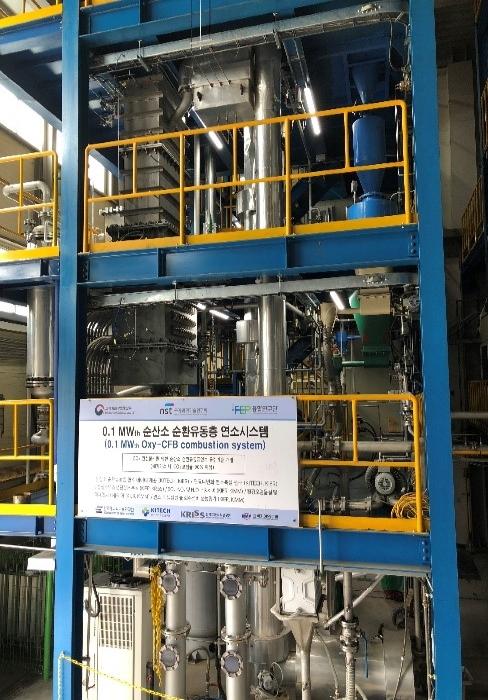FEPCRC in KIER develops Oxy-CFBC technology to separate CO2 over 90% at 60% of O2 as an oxidant for combustion. Removing over 80% of air pollutants causing ultra fine dust compared to air mode combustion

Credit: Korea Institute of Energy Research (KIER)
Coal-fired power plants in Korea have been considered as one of the main sources of air pollutants, CO2 and the other precursor materials to ultra fine dusts such as nitrogen oxide, sulfur oxide. Therefore, FEPCRC is developing key technologies for eco-friendly coal-fired stackless power generation without emissions in flue gas.
FEP Convergence Research Center(FEPCRC) led by Director Lee Jae-goo in Korea Institute of Energy Research(KIER, President: Kim Jong-nam) successfully developed ‘Oxy-Circulating Fluidized Bed Combustion (Oxy-CFBC)’ technology that reduces air pollution over 80% and separates over 90% of CO2 emissions compared to existing power plant with air mode combustion.
Oxy-CFBC is a promising and advanced combustion technology that makes it possible to separate CO2 efficiently, utilize low grade fuels and remove SOx and NOx by oxy-combustion process combined with CFBC technology.
This process operates below 950 ? and does not produce thermal NOx compared to other types of thermal power generation that requires a high operating temperature. In addition, it allows to remove NOx and SOx with injecting the reducing agents such as urea/ammonia solutions and the limestone particles inside combustor. As a results, the burdens of installing flue gas treatment system can be reduced.
Since Oxy-CFBC uses oxygen mixed with recirculating CO2 instead of air as an oxidant and requires only air separation unit and flue gas recirculation system, it is easier to obtain highly concentrated CO2 compared to other carbon capture technologies. Moreover, this process can reduce about 80% of the amount of air pollutants generating ultra fine dust as well as the amount of flue gas compared to air mode combustion.*
* The effects of air pollutants reduction during oxy-combustion is as follows; sulfur dioxide: 80%, nitric oxide: 85%, carbon monoxide: 76%
FEPCRC developed Oxy-CFBC technology with flue gas recirculation system for the first time in Korea. This Oxy-CFBC process is one of the most advanced technologies that can be operated at 60% of O2 as an oxidant for oxy-combustion.
The higher oxygen concentration for Oxy-CFBC plays a critical role to improve the system efficiency. Developed technologies until now use oxygen concentration at the level of 40%, but if oxygen concentration increases over 60%, the size of CFBC and down stream facilities can be reduced significantly, resulting in the reduction of capital cost and operating expenses.
It was shown from Oxy-CFBC test-rig that thermal input can increase from 100 kWth to 200 kWth when oxygen concentration increases from 21% to 60%. This means that thermal power can be doubled in constant plant size or the plant size can be reduced for the constant thermal power.
FEPCRC also developed stable oxidants switching technology from air mode combustion to oxy mode combustion or vice versa for combustion and could obtain high concentration CO2 over 90% within one hour after oxidant switching from air to oxy mode.
Dr. Mun of FEPCRC who participating in this R&D said,”It is urgent to develop breakthrough technologies for CO2 and fine dust reduction. Our research team will continue to make an effort to develop basic design, engineering, and operating techniques related to Oxy-CFBC process with our own technologies, contributing to demonstration for advanced power generation technology that can separate CO2 during combustion process.”
###
This research project participating Korea Institute of Industrial Technology (KITECH), Korea Research Institute of Standards and Science(KRISS) and Korea Institute of Machinery and materials(KIMM) as well as KIER is performing now as a convergence research program, with the aim of developing an eco-friendly stackless power plant without CO2 and fine dust emissions.
Media Contact
Woo Eugene
[email protected]
Related Journal Article
http://dx.




